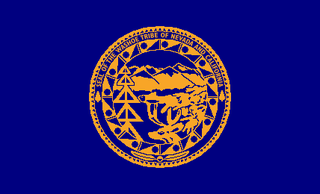
The Washoe or Wašišiw are a Great Basin tribe of Native Americans, living near Lake Tahoe at the border between California and Nevada. The name "Washoe" or "Washo" is derived from the autonym Waashiw in the Washo language or from Wašišiw (waší:šiw), the plural form of wašiw.

Washo is an endangered Native American language isolate spoken by the Washo on the California–Nevada border in the drainages of the Truckee and Carson Rivers, especially around Lake Tahoe. While there are only 20 elderly native speakers of Washo, since 1994 there has been a small immersion school that has produced a number of moderately fluent younger speakers. The immersion school has since closed its doors and the language program now operates through the Cultural Resource Department for the Washoe Tribe. The language is still very much endangered; however, there has been a renaissance in the language revitalization movement as many of the students who attended the original immersion school have become teachers.
Cahuilla traditional narratives include myths, legends, tales, and oral histories preserved by the Cahuilla people of the Colorado Desert and Peninsular Ranges of southern California.
Plains Miwok and Sierra Miwok traditional narratives include myths, legends, tales, and oral histories preserved by the Miwok people of the central California, specifically those of Sacramento Valley and Sierra Mountains. These Miwoks are the linguistically related speakers of the Plains and Sierra Miwok languages and their descendants. At the time of European entry, local groups that spoke these languages participated in the general cultural pattern of central California.
Hupa traditional narratives include myths, legends, tales, and oral histories preserved by the Hupa, Chilula, and Whilkut people of the Trinity River basin and vicinity of northwestern California. The Hupa people of modern times number in the several thousands and live in the Hoopa Valley located in Humboldt County, California.
Kato traditional narratives include myths, legends, tales, and oral histories preserved by the Kato (Cahto) people of the Eel River basin of northwestern California.
Kumeyaay traditional narratives include myths, legends, tales, and oral histories preserved by the Kumeyaay people of southern California and northwestern Baja California.
Kitanemuk traditional narratives include myths, legends, tales, and oral histories preserved by the Kitanemuk people of the Tehachapi Mountains, southern Sierra Nevada, and the western Mojave Desert of southern California.
Lake Miwok traditional narratives include myths, legends, tales, and oral histories preserved by the Lake Miwok people of Clear Lake in the North Coast Range of northwestern California.
Luiseño traditional narratives include myths, legends, tales, and oral histories preserved by the Luiseño people of southwestern California.
Maidu traditional narratives include myths, legends, tales, and oral histories preserved by the Maidu, Konkow, and Nisenan people of eastern Sacramento Valley and foothills in northeastern California.
Mono traditional narratives include myths, legends, tales, and oral histories preserved by the Mono people, including the Owens Valley Paiute east of the Sierra Nevada and the Monache on that range's western slope, in present-day eastern California.
Northern Paiute traditional narratives include myths, legends, tales, and oral histories preserved by the Northern Paiute people of the Great Basin deserts of western Nevada, eastern California, and southeastern Oregon in the United States of America.
Shasta traditional narratives include myths, legends, tales, and oral histories preserved by the Shasta people of northern California and southern Oregon.
Tolowa traditional narratives include myths, legends, tales, and oral histories preserved by the Tolowa people of Smith River area of northwestern California and southwestern Oregon.
Wintu-Nomlaki traditional narratives include myths, legends, tales, and oral histories preserved by the Wintu and Nomlaki people of the western Sacramento Valley in northern California.
Wiyot traditional narratives include myths, legends, tales, and oral histories preserved by the Wiyot people of the Humboldt Bay area of northwestern California.
Yokuts traditional narratives include myths, legends, tales, and oral histories preserved by the Yokuts people of the San Joaquin Valley and southern Sierra Nevada foothills of central California.
Yuki traditional narratives include myths, legends, tales, and oral histories preserved by the Yuki people of the upper Eel River area of northwestern California.
Yurok traditional narratives include myths, legends, tales, and oral histories preserved by the Yurok people of the lower Klamath River in northwestern California.